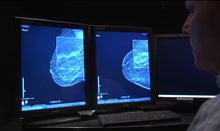
The 3D imaging technique has proven to be more accurate than conventional mammography at detecting breast cancers, and it produces fewer false-positives for patients.
Emory Healthcare is now offering the most advanced breast imaging technology available to be used in the early detection of breast cancer. Tomosynthesis, or 3D, mammography breast exams are available to patients at three locations: the breast imaging centers at the Winship Cancer Institute on Emory’s Clifton Campus, Emory University Hospital Midtown and Emory Johns Creek Hospital.
This FDA-approved mammography technology, which is typically not covered by insurance, will be offered at no additional charge above the cost of a traditional 2D digital mammogram to patients receiving their annual screening mammogram.
The 3D imaging technique has proven to be more accurate than conventional mammography at detecting breast cancers, and it produces fewer false-positives that result in patient call-backs for additional testing. Conventional mammography displays the breast in a single, flat 2D image; during a 3D mammogram, X-ray equipment sweeps across the breast in an arc taking multiple low-dose images of the tissue. A high-powered computer then converts the images of the breast into very thin layers creating a three-dimensional view. The 3D exam takes only a few seconds longer than the 2D mammogram, but requires no additional compression of the breast.
"Compared with 2D mammography, a 3D exam allows radiologists to view the breast in small slices providing more detailed pictures of specific areas," says Michael A. Cohen, MD, director of Breast Imaging for Emory Healthcare. "The state of the art technology is proven to reduce call-backs by 20 to 40 percent and finds more cancers, particularly in women with dense breast tissue."
The radiation exposure in a 3D mammogram is higher than the traditional 2D mammogram but well below the limit set by the FDA for screening mammography. Cohen says the trade-offs in terms of fewer unnecessary call-backs and improved cancer detection far outweigh the slightly higher radiation dose. The exams are approved for all women who would undergo a standard screening mammogram.
Mammography screening has been shown to detect breast cancer in earlier stages, which can lead to better chances for a cure. An annual screening mammogram is recommended for all women at average risk for breast cancer starting at age 40.
